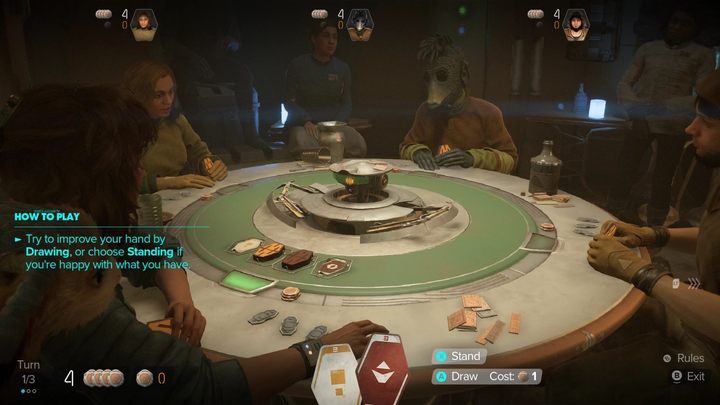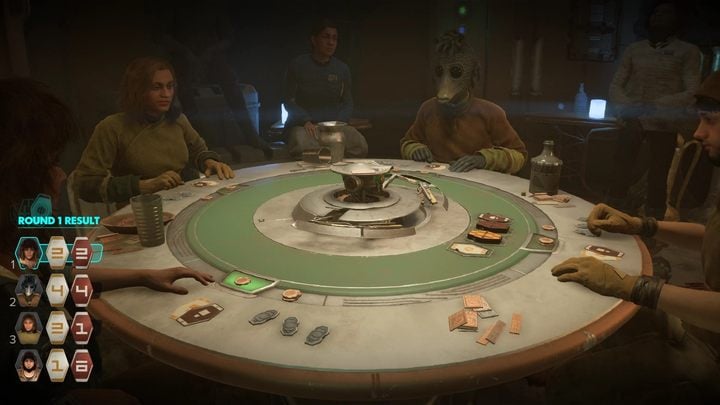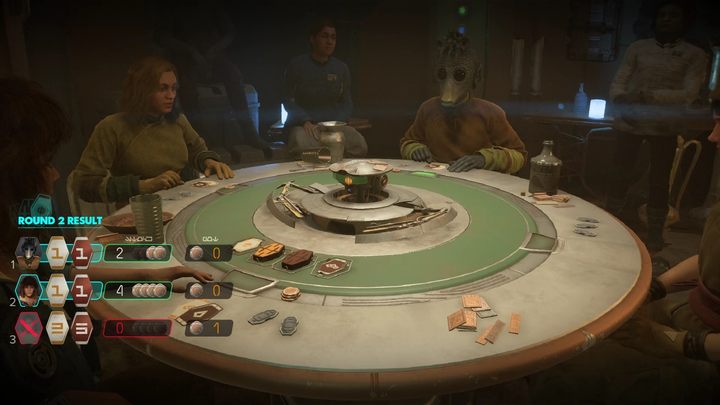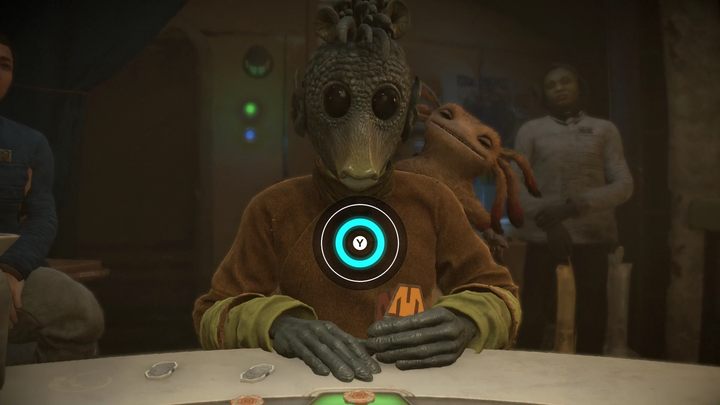Star Wars Outlaws: How to play Kessel Sabacc?
Kessel Sabak is a card game that acts as an elaborate mini-game in the world of Star Wars Outlaws. On this page of the guide we have described how to play Kessel Sabak, how the various cards and trick tokens work.
Kessel Sabacc is the most extensive mini-game in Star Wars Outlaws - a gambling card game played by many of the residents of the cities you visit. You can play sabacc at dedicated tables, which you can find in almost every settlement - although you have to pay to join the game, winning will reward you with a significant amount of money. Your first win at each table will also earn you a unique reward. On this page we describe how to play sabacc, what are the rules, how the individual cards and shift tokens work.
- Basic assumptions of the game
- Decks and types of cards
- Cards values
- Tokens
- Shift Tokens
- Cheating
- Course of the game
Basic assumptions of the game

Kessel Sabacc is a card game for four players. The aim of the game is to get a pair of identical cards of the lowest value. Each player is dealt two cards at the beginning of the round, which they can either hold or invest tokens (which the game calls paying a tax) to draw potentially better cards. At the end of the round, the player with the best pair of cards gets back all of their invested tokens, while the other players lose them and must pay an additional penalty. A player who ends the round with no tokens is eliminated from the game. The last player remaining at the table wins.
Decks and types of cards

Each player has two decks of cards - yellow and red. You can only have one yellow and one red card in your hand at any time. The decks are identical and consist of the following cards:
- Number cards - basic cards with values from 1 to 6. Each deck contains three cards of each numbering (three threes, three sixes, etc.)
- Impostor Cards - special cards with dice marking. At the end of the round, the player rolls two dice for each impostor card held. The player then selects one of the dice - the impostor card held takes on the value rolled on that die. There are three impostor cards in each deck.
- Sylop Cards - special cards with a compass marking. At the end of the round, the sylop card held takes on the value of the other card held, guaranteeing a sabacc. Each deck contains one sylop card.
Cards values

At the end of the round, the two cards a player holds are his final hand, and their value determines victory or defeat. A rule of thumb to remember is that the lower the numbering, the better the hand. The value of each hand, from best to worst, looks like this:
- Pure Sabacc - a pair of sylops, the best hand in the game.
- Sabacc - a pair of cards with the same numbering. The lower the numbering, the better, e.g. a pair of twos is better than a pair of fours.
- No Sabacc - a pair of cards with different numbering. The lower the difference between the cards, the better, e.g. a five and a two (difference is 3) is better than a six and a one (difference is 5).
Any sabacc is always better than no sabacc - for example, a pair of sixes always beats a one and a two.
Tokens

Each player starts the game with an identical number of tokens, which represent money - the more there are, the longer the game lasts. Each table is played with a different number of token. The aim of the game is to keep your tokens and not go bankrupt by making other players to lose theirs.
Drawing a card during your turn costs one token - it gets invested. If a player chooses not to draw a new card or cannot afford the investment, he or she does not have to invest. At the end of the round, the player with the best hand gets back all the tokens they invested in that round. The remaining players lose their invested tokens and must pay an additional penalty - one token if they had sabacc, or an amount of tokens equal to the difference between their cards if they did not have sabacc.
Shift Tokens

During the game, each player has three shift tokens (these are not related to the regular tokens) that they can use at the start of their turn. They are picked at the beginning of the game. Each token can only be used once during a given game, and only one token can be used per turn. Tokens have various effects, such as the ability to draw a card for free, forcing other players to immediately invest tokens, or getting back tokens you have invested.
New shift tokens can be found throughout the game world through exploration, shopping, mini-games, etc. On further planets, opponents have access to more powerful tokens, so remember to upgrade your collection to keep up with them.
Cheating

During the player's turn, Kay may attempt to cheat, e.g. send Nix to check opponent's cards. Cheating requires completing a short QTE. Failure will make other players more suspicious and you will be forced to talk your way out of the troubles. If other players discover that Kay is cheating, the game will end. Kay will be banned from playing at this table - you will have to wait quite a while before you can play there again. You can acquire different cheating methods in the form of expert skills.
Course of the game
Here is a more detailed description of a complete game of sabacc:
- Each round consists of three turns. At the beginning of the round, each player is dealt two cards - one yellow and one red.
- During their turn, a player may optionally play one shift token. They must then make a choice - do nothing or invest a token and draw a new card from the yellow or red deck. If a player draws a card, he or she has two cards of the same color in their hand - they must choose one of those cards and discard it.
- A round ends after three turns or if no player draws a card during that turn. Players compare the cards they are holding - those holding the impostor cards must roll the dice to determine their value.
- The player with the best hand gets their invested tokens back. The remaining players lose their invested tokens and pay an additional fine. If there is a tie for first place, e.g. two players have a pure sabacc, all tied players get their invested tokens back. Players who end the round with no tokens are eliminated.
- The game ends when only one player remains at the table. This player wins the entire game.
- Star Wars Outlaws Guide
- Star Wars Outlaws: Game Guide
- Star Wars Outlaws: FAQ
- Star Wars Outlaws: Mechanics
- Star Wars Outlaws: How does the reputation system work?
- Star Wars Outlaws: How does the experts system work?
- Star Wars Outlaws: How to save the game?
- Star Wars Outlaws: Can you use other weapons?
- Star Wars Outlaws: How to heal your character and increase your Bacta Vial carry limit?
- Star Wars Outlaws: Is stealth necessary? Stealth tips
- Star Wars Outlaws: How to stun droids and elite enemies?
- Star Wars Outlaws: How to play Kessel Sabacc?
- Star Wars Outlaws: Mechanics
- Star Wars Outlaws: FAQ
- Star Wars Outlaws: Game Guide
You are not permitted to copy any image, text or info from this page. This site is not associated with and/or endorsed by the developers and the publishers. All logos and images are copyrighted by their respective owners.
Copyright © 2000 - 2025 Webedia Polska SA for gamepressure.com, unofficial game guides, walkthroughs, secrets, game tips, maps & strategies for top games.
